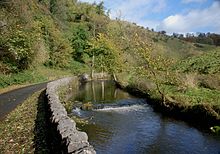River Dove, central England
| Dove (Derbyshire & Staffordshire) | |
|---|---|
Milldale, Dovedale | |
| Physical characteristics | |
| Source | Dove Head |
| • location | Axe Edge Moor, Peak District, England |
| • coordinates | 53°13′04″N 1°56′36″W / 53.21790°N 1.94346°W |
| • elevation | 84 m (276 ft) |
| Mouth | |
• location | Newton Solney, Derbyshire, England |
• coordinates | 52°49′54″N 1°35′10″W / 52.83156°N 1.58601°W |
| Length | 72 km (45 mi) |
| Basin features | |
| Tributaries | |
| • right | River Manifold, River Churnet |
The River Dove (
The river is a famous trout stream. Charles Cotton's Fishing House, which was the inspiration for Izaak Walton's The Compleat Angler,[3] stands in the woods by the river near Hartington.
The river's name is now usually pronounced to rhyme with "love", but its original pronunciation rhymed with "rove". This pronunciation is still used by some residents of the lower reaches of the river.[4]
Dovedale


From
Good riverside paths make the whole route accessible to walkers.
Much of the dale is in the ownership of the
Dovedale's attractions include rock pillars such as Ilam Rock,[6] Viator's Bridge, and the limestone features Lovers' Leap and Reynard's Cave.[7]
Lower Dove
Once the river leaves Dovedale it combines with the Manifold and enters a wider valley near Thorpe. The valley increases in size as the river continues south to reach Mapleton and then Mayfield, where it is crossed by the medieval Hanging Bridge. At this point it is joined by the Bentley Brook, and then nearby at Church Mayfield, by the Henmore Brook.[8]
The Dove now flows in a south-westerly direction, passing Norbury and Ellastone, where it turns south until it reaches Rocester. To the south of the village, at Combridge it is joined by its largest tributary the River Churnet. As it reaches the ancient Dove Bridge, it is joined by the River Tean, the river now meandering through a wide valley which turns east as it passes between Doveridge and Uttoxeter; the only town along its length.[8]
Beyond this point riverside communities, such as
Tributaries

Alphabetical list of tributaries, extracted from the Water Framework Directive list of water bodies for the River Dove:[9]
- Alders Brook which joins the Dove near Rocester
- Bentley Brook
- River Churnet
- Foston Brook which joins the Dove near Rocester
- Henmore Brook
- Hilton Brook
- River Manifold
- Marchington Brook which joins the Dove near Marchington
- Marston Brook which joins the Dove near Marchington
- Picknall Brook which joins the Dove near Uttoxeter
- Rolleston Brook which joins the Dove near Rolleston on Dove
- River Tean
- Tit Brook which joins the Dove near Ellastone
See also
- Rivers of the United Kingdom
- List of rivers of England
References
- ^ "River Dove". Peak District Information. Retrieved 9 July 2014.
- ^ "The Peak District National Park – Fact Zone 8. Dovedale and the Dove Valley". www.peakdistrict-education.gov.uk. Archived from the original on 8 March 2010. Retrieved 4 April 2008.
- ^ "BBC – Radio 4 – The Philosopher, Fish and the Dove". www.bbc.co.uk. Retrieved 4 April 2008.
- ^ Staffordshire. Charles Masefield. 1918. p. 122. Retrieved 23 May 2020.
- ^ "Dovedale – Dovedale in Derbyshire and the Peak District". www.derbyshireuk.net. Retrieved 4 April 2008.
- ^ "Walks in The Peak District – Dove Dale and Wolfscote Dale walk". www.walkingenglishman.com. Retrieved 4 April 2008.
- ^ "National Trust – Ilam Park, Dovedale". www.nationaltrust.org.uk. Archived from the original on 17 March 2008. Retrieved 4 April 2008.
- ^ a b c "Get-a-map online". Ordnance Survey. Retrieved 26 March 2013.
- ^ "Water Framework Directive Surface Water Classification Status and Objectives 2012 csv file". Environment Agency.gov.uk. 26 November 2012. Archived from the original on 24 February 2014. Retrieved 10 February 2013.
